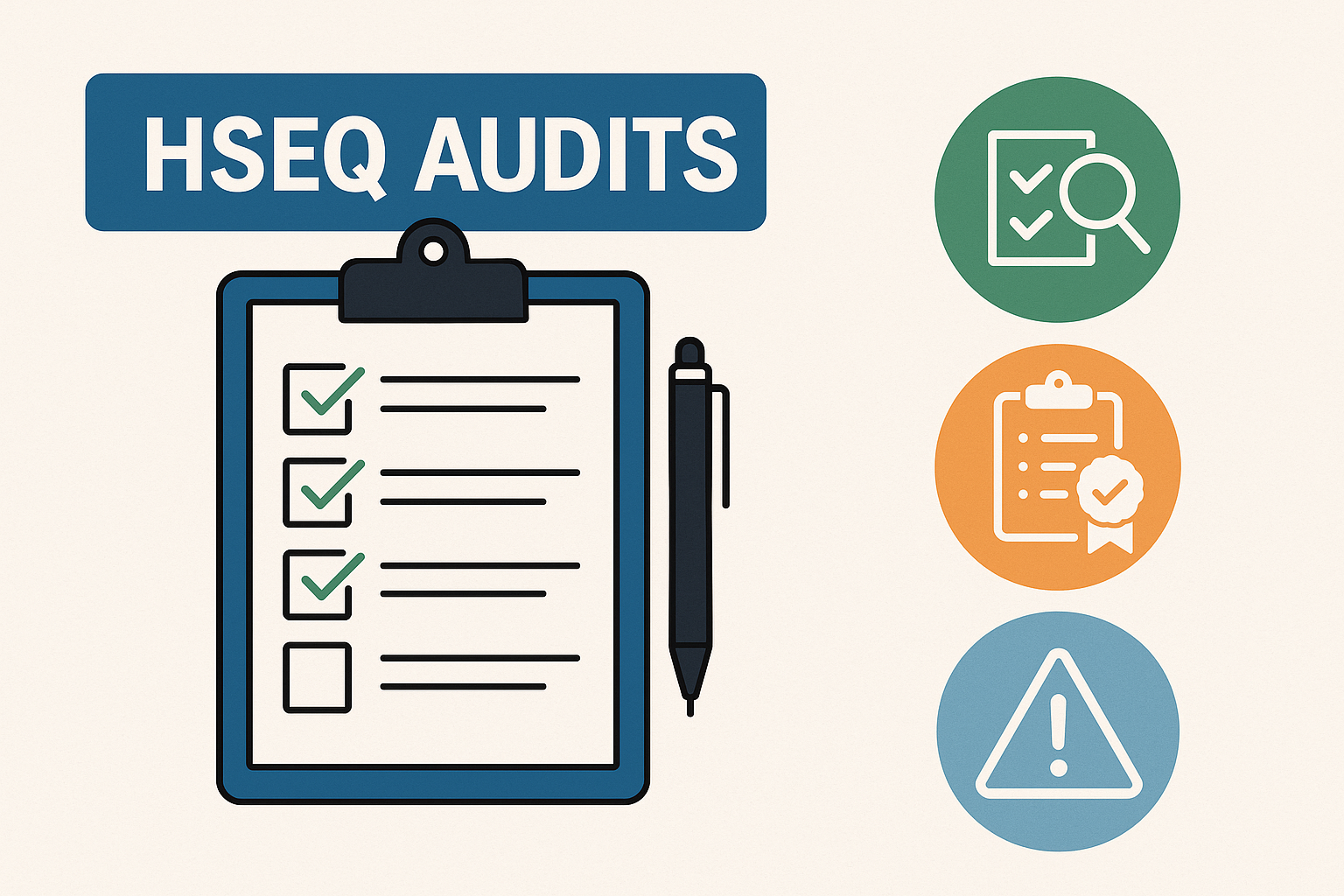HSEQ audits—covering Health, Safety, Environment, and Quality—are powerful tools that help organizations ensure their systems are compliant, effective, and continuously improving.
These audits go beyond checklists—they assess real-world performance, identify risks, and uncover opportunities to strengthen workplace operations.
Whether you’re preparing for your first audit or optimizing an existing process, understanding how HSEQ audits work is critical for long-term success.
What Is an HSEQ Audit?
An HSEQ audit is a systematic examination of how well an organization is managing its health, safety, environmental, and quality responsibilities.

It involves evaluating procedures, operations, documentation, employee awareness, and compliance with applicable laws, standards, and company policies.
There are two main types:
- Internal Audits: Conducted by in-house teams to evaluate readiness, identify weaknesses, and ensure continuous improvement.
- External Audits: Performed by third-party certifiers or regulators to verify compliance with standards like ISO 9001, ISO 14001, or ISO 45001.
Why HSEQ Audits Are Essential
A well-executed audit reveals how effectively an organization:
- Complies with legal and regulatory requirements
- Manages risks and prevents incidents
- Delivers consistent product/service quality
- Minimizes environmental impact
- Drives a culture of accountability and improvement
HSEQ audits can also uncover non-conformities, improve resource efficiency, and reinforce a company’s reputation for excellence and compliance.
Core Components of an HSEQ Audit
✅ 1. Health Audit Focus
Assesses workplace health risks, employee well-being programs, medical surveillance, exposure to hazardous substances, and alignment with standards like ISO 45001.
✅ 2. Safety Audit Focus
Reviews hazard identification, incident reporting, PPE usage, training records, emergency preparedness, and overall safety culture.
✅ 3. Environmental Audit Focus
Examines waste management, emissions, pollution prevention, sustainability initiatives, and compliance with ISO 14001 or environmental laws.
✅ 4. Quality Audit Focus
Evaluates consistency in processes, customer satisfaction, product specifications, corrective actions, and adherence to ISO 9001 quality systems.
How to Prepare for an HSEQ Audit
Proper preparation sets the stage for a smooth and successful audit. Steps include:
- Review Documentation: Ensure all policies, procedures, SOPs, and records are current and easily accessible.
- Conduct Internal Checks: Perform mock audits and self-assessments to detect and fix issues in advance.
- Train Staff: Make sure employees understand their roles, procedures, and audit expectations.
- Assign Responsibilities: Designate audit leaders and process owners to manage specific audit areas.
- Ensure Corrective Actions: Close out previous audit findings and verify implementation of improvements.
The Audit Process: Step-by-Step
| Step | Description |
|---|---|
| 1. Planning | Define scope, schedule, and objectives. Assign audit team members. |
| 2. Opening Meeting | Align expectations between auditors and auditees. |
| 3. Document Review | Analyze QMS, EHSMS, and policy documents. |
| 4. Field Assessment | Observe operations, interview employees, inspect work areas. |
| 5. Findings and Evaluation | Identify conformities, non-conformities, and opportunities for improvement. |
| 6. Closing Meeting | Present preliminary findings and clarify next steps. |
| 7. Final Report | Deliver formal audit report with observations, evidence, and action items. |
Common Audit Findings in HSEQ
| Non-Conformity | Typical Cause |
|---|---|
| Missing PPE logs | Poor recordkeeping or training |
| Unlabeled chemical containers | Weak hazard communication |
| Incomplete incident reports | Lack of follow-up or unclear roles |
| Waste not segregated properly | Environmental non-compliance |
| No CAPA process for complaints | Weak quality oversight |
Tools and Standards Used in HSEQ Audits
- ISO 9001 – Quality Management Systems
- ISO 14001 – Environmental Management Systems
- ISO 45001 – Occupational Health and Safety
- OHSAS 18001 – (Legacy standard, now replaced by ISO 45001)
- WHMIS/GHS – Hazard communication (Canada/global)
- PDCA Cycle – Plan-Do-Check-Act method for continuous improvement
- Checklists and Risk Matrices – Structured tools for consistent audit performance
Integrating HSEQ Audits into Continuous Improvement
HSEQ audits should not be one-off events—they should feed directly into your continuous improvement process. Use audit results to:
- Update training and awareness programs
- Modify risk assessments and procedures
- Guide management reviews and strategic planning
- Monitor trends through audit data and KPIs
This integration ensures that audits become catalysts for meaningful change rather than routine formalities.
Digital Solutions for Smarter Audits
Modern audit software and mobile tools streamline the HSEQ audit process. Platforms like iAuditor, Intelex, and ETQ Reliance help manage checklists, assign actions, and generate reports in real time.
Benefits of using digital audit tools include:
- Better visibility of compliance trends
- Easier data capture and analysis
- Real-time reporting and notifications
- Secure document storage and audit trails
Conclusion: Make HSEQ Audits a Strength, Not a Stress
HSEQ audits are essential tools for evaluating and improving how your organization protects health, ensures safety, safeguards the environment, and delivers quality. When conducted effectively, they provide a roadmap to compliance, operational excellence, and stakeholder trust.
Treat your next audit as more than a box-ticking exercise—embrace it as a strategic opportunity to make your workplace safer, greener, and better aligned with your core values.
Leave a Reply